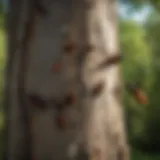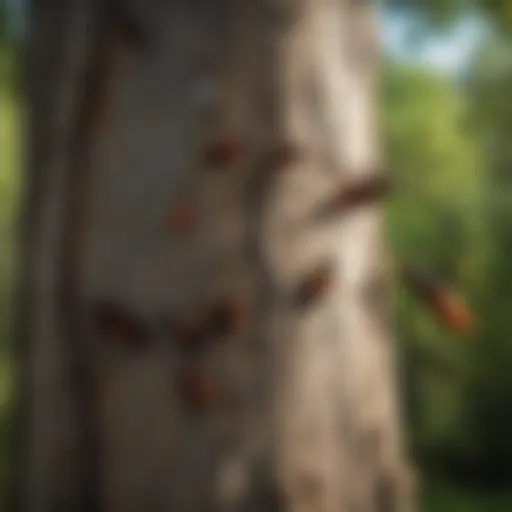Finding Bleeding Heart Plants: Key Locations & Tips
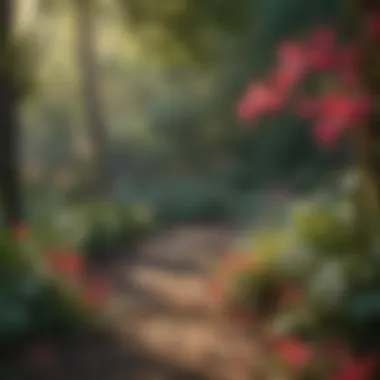

Intro
Bleeding heart plants, with their unmistakable heart-shaped flowers, are a perennial favorite in many gardens across the United States. Their unique appearance and fascinating growth patterns offer not only joy to the eye but also a chance to learn about their intriguing ecological role.
This guide aims to take you through the specific avenues for discovering these exquisite plants, emphasizing both their natural habitats and the practical techniques for cultivating them. Whether you're a novice gardener or a seasoned environmentalist, understanding where bleeding hearts thrive provides insight into their unique characteristics and accompanying ecosystems. Let's delve deep into how to find and appreciate these stunning flora in their natural setting.
Understanding the Bleeding Heart Plant
Bleeding heart plants, with their striking heart-shaped flowers, hold a special place not only in the realm of horticulture but also in the hearts of many who appreciate naturally occurring beauty. Understanding this plant goes beyond merely identifying its physical traits; it touches upon the broader context of its existence and cultural relevance. These perennial icons offer a wealth of benefits not just visually, but ecologically as well.
Botanical Classification
To delve into the essence of bleeding heart plants, it is essential to grasp their botanical classification. The genus Dicentra is where these plants belong. Inside this category, Dicentra spectabilis, commonly known as the common bleeding heart, is perhaps the most recognized. They typically bloom in the spring, presenting lovely pink or white flowers that dangle like pendants from arching stems. Their delicate appearance often leads one to wonder about their structure and resilience.
These plants thrive in USDA Hardiness Zones 3 through 9, displaying a preference for cooler climates. Understanding these classifications helps enthusiasts discern the proper environments needed for cultivation and ensures successful growth in gardens across various regions.
Planting Tip: Knowing the specific species and the hardiness range can greatly affect your overall gardening success with bleeding hearts.
Cultural Significance
The cultural importance of the bleeding heart plant stretches across different communities and traditions. In various parts of the world, it symbolizes deep emotional ties. Its unique flower shape has been linked to themes of love, compassion, and even mourning. In Japanese culture, for example, the plant is called “shakuyaku,” associated with the concept of good fortune and enduring affection.
Gardeners often choose to incorporate these plants into their landscapes not only for their striking aesthetics but also for the emotional resonance they convey.
Moreover, bleeding hearts have earned a spot in traditional medicine, where they have been employed for their purported health benefits, including anti-inflammatory properties. Understanding their cultural background adds layers to the appreciation of the plant, reflecting how human connections to nature help shape gardening practices.
By examining botanical classification and cultural significance, gardeners can foster a deeper connection with bleeding heart plants, enhancing their appreciation not only for the physical beauty these flowers bring but also for the rich history they embody.
Natural Habitats of Bleeding Heart Plants
Understanding the natural habitats of bleeding heart plants is crucial for anyone looking to cultivate or simply appreciate these delicate beauties. These plants thrive under specific environmental conditions that not only support their growth but also enhance their ability to contribute to local ecosystems. By grasping where they naturally flourish, one can effectively recreate their ideal growing circumstances in a garden or landscape layout.
Woodland Areas
Bleeding hearts typically sprout in woodland areas that provide a tapestry of rich biodiversity. Forest understoreys, where light can filter through the canopy, create a microenvironment that suits these plants. The leaf litter and decaying organic matter enrich the soil, providing necessary nutrients. In the wild, you might find them nestled among ferns and other shade-loving plants, creating a picturesque landscape that mirrors their natural habitat.
It's interesting to note that these spots often have a stable moisture level, preventing the soil from drying out. Thus, when looking for bleeding heart plants, seeking out wooded regions can guide your quest. Such locations often provide clues about the ideal conditions for cultivation, as they reveal how these plants interact with their environment and other species.
Moist Soil Preferences
In addition to woodlands, bleeding hearts have a particular fondness for moist soil. This preference stems from their evolved need to remain hydrated, as they hail from areas with consistent moisture levels. Soil that is well-drained yet retains some moisture is paramount; think of soil that holds onto moisture without becoming waterlogged. Amending garden beds with organic material can mimic these conditions effectively.
To give you an idea: if the soil in your garden resembles a sponge that doesn't let water pool but stays damp, you're likely on the right track for growing bleeding hearts. Furthermore, understanding their moisture needs should guide you in decisions regarding irrigation and companion planting, creating a thriving garden ecosystem.
Shade Tolerance
Perhaps one of the most striking features of bleeding heart plants is their high shade tolerance. Unlike many garden flowers that bask in full sunlight, these plants flourish under the gentle embrace of partial to full shade. This ability to thrive in low light conditions makes them ideal candidates for areas where direct sun may be scarce, such as under large oaks or near patio overhangs.
It's worth mentioning that while shade is beneficial, it's not a license for neglect. Even in shaded areas, ensuring sufficient air circulation and maintaining a proper moisture level in the soil remains vital for their health. This resilience further illustrates their role in diverse plant communities, often serving as a bridge between ground cover and higher forest plant layers.
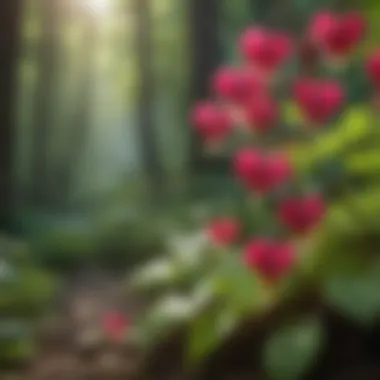

"Being able to identify the habitats where bleeding heart plants thrive not only encourages their growth but also fosters a deeper appreciation for the natural ecosystems they belong to."
Understanding where bleeding heart plants naturally grow is like peering into a treasure map of possibilities for any enthusiastic gardener or ecologist. By honing in on these natural habitats, you're better equipped to recreate the conditions necessary for these remarkable plants to flourish.
Where to Find Bleeding Heart Plants
Finding bleeding heart plants can be both rewarding and a bit of a thrill, especially for those with a keen eye for the unique beauty of these perennials. This section focuses on crucial places where enthusiasts can locate these charming plants, whether for personal gardens, research, or educational purposes. Knowing where to find bleeding hearts offers practical benefits—such as ensuring a healthier plant or discovering rare varieties—and also encourages community engagement around this beloved species.
Botanical Gardens
Botanical gardens serve as a treasure trove for anyone seeking bleeding heart plants. These gardens often feature a variety of flora, including cultivated specimens of the Dicentra spectabilis, which is the most recognized type of bleeding heart.
Visitors can take advantage of unique collections, often including rare strains not typically available at nurseries. Besides, botanical gardens usually have knowledgeable staff who can provide valuable insights on the nuances of growing these plants. When planning a visit, check their calendars for guided tours or workshops that dive deeper into the cultivation of bleeding hearts.
Local Nurseries
Local nurseries are another prime location for sourcing bleeding heart plants. These establishments often carry a range of perennials tailored for the particular climates and conditions of the region. Staff members in these nurseries are usually quite passionate about plants and can share personal experiences about their care.
It's worth mentioning that local nurseries tend to prioritize native plants, and bleeding hearts can often thrive alongside others that are well-adapted to the area's soil and moisture conditions. Ensure that you visit in early spring or late summer; this is typically when these blooms are at their finest and most available for purchase.
Wildflower Reserves
Wildflower reserves represent a more natural habitat for bleeding heart plants. Although foraging for plants from the wild should be approached with caution and respect for conservation laws, these reserves often allow visitors to admire these plants in their native settings.
In wildflower preserves, you can witness the plants thriving in conditions closely mimicking their natural habitats: moist soil with plenty of shade.
Plan excursions during the blooming season to witness the beauty firsthand. Taking pictures and observing their environment can provide insights into ideal growing conditions, which can later benefit your gardening efforts.
Plant Exchanges
Participating in local plant exchanges is a community-driven way to find bleeding heart plants. These gatherings allow people to trade plants, seeds, and gardening tips. Such events not only increase your chances of finding these beloved perennials, but they also foster a sense of community and shared passion for horticulture.
Search for local gardening clubs or online platforms that arrange these exchanges. Many participants come with stories and advice, sharing the particularities of their bleeding hearts, which might not be easily found in gardening books. To summit, exchanging plants is a sustainable way to cultivate your garden without incurring hefty costs.
"Finding bleeding heart plants isn't just about the hunt; it's about connecting with others who reverence nature just as much as you do."
These avenues for acquiring bleeding heart plants aren't merely practical; they embody a larger narrative of shared stewardship and the love for nature. By knowing where to look, you’ll enrich both your gardening endeavors and your connection to the environment.
Cultivating Bleeding Heart Plants
Cultivating bleeding heart plants is not just about beautifying a garden; it’s about understanding the nuances that facilitate their growth and ensure their vivid blooms year after year. These perennial plants, with their striking, heart-shaped flowers, offer not only aesthetic value but also play a crucial role in local ecosystems. As such, proper cultivation techniques are essential for maintaining their health, fostering their natural habitats, and promoting biodiversity. Understanding the primary factors necessary for cultivating these unique plants can empower gardeners, sufficing their passion for beauty while supporting environmental sustainability.
Soil Requirements
Growing a bleeding heart will invariably lead you to consider its soil requirements. The right soil sets the stage for thriving plants, making this aspect an essential building block for successful cultivation.
Drainage Needs
Good drainage is pivotal when cultivating bleeding heart plants. These plants flourish in well-draining soil, as water that cannot escape can lead to root rot, a problem no gardener wants to encounter. Bleeding hearts prefer a loamy mix; this blend not only retains moisture but also allows excess water to drain away.
A common characteristic of bleeding hearts is their preference for slightly acidic to neutral pH levels. The drainage in your garden should provide a welcoming environment for them to stretch their roots without the fear of drowning. This feature makes well-draining soil vital, promoting healthy growth and colorful blooms that catch anyone's eye. However, gardeners should be aware that overly sandy soil can lead to nutrient loss, so balancing drainage with organic matter is crucial.
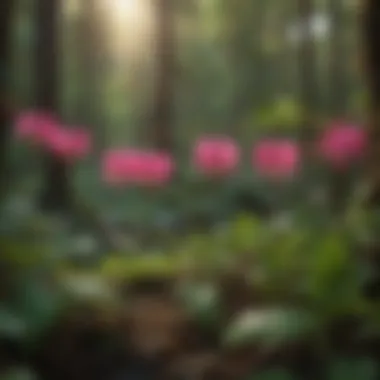

Nutrient Content
Next on the list of soil requirements is the nutrient content. A nutrient-rich soil is the lifeline for your bleeding heart plants, providing the necessary elements for vibrant blooms and robust foliage. Incorporating organic compost into the soil not only enriches it with vital nutrients but also enhances its structure. These elements contribute to better moisture retention and encourage microbial activity, supporting overall soil health.
What makes nutrient content stand out is its ability to drive your plant’s growth cycle efficiently. Healthy, well-fed plants boast dense foliage and flamboyant flowers. However, there's a downside; if the nutrient levels in the soil teeter on excess, it can lead to lush foliage with fewer blooms. It's essential to strike a balance, ensuring that while they have the nourishment they need, they still thrive aesthetically.
Temperature Considerations
Next, let’s shift our focus to temperature considerations. The climate where you grow your bleeding heart plants significantly affects their success.
Ideal Climate Zones
Bleeding hearts are hardy plants; however, they do have a fondness for certain climate zones. They thrive best in USDA hardiness zones 3 to 9, where winters are cold enough to initiate their dormancy yet mild enough to support their growth in spring. This key characteristic of ideal climate zones reveals how choosing the right region can be game-changing for any gardener.
A unique feature of these zones is that they provide a predictable climate that suits the plants' natural growth cycles. For instance, in cooler areas, bleeding hearts can bloom in early spring, while in milder climates, they may offer a longer display of flowers. However, gardeners in hot zones should take caution; intense heat can stress the plants out, prompting them to wilt or lose flowers prematurely.
Frost Resistance
Another crucial consideration is frost resistance. While bleeding heart plants can withstand some frost, the first frost of the season can wreak havoc if they’re not prepared. A common trait of these plants is their ability to go dormant during colder months, which is why understanding local frost dates plays a fundamental role in cultivation.
Frost resistance relates directly to the timing of your planting. If planted too late in the spring, young plants may not have enough time to become established. On the other hand, late plantings might face cold snaps that can damage new growth. Positioning these plants in somewhat sheltered spots can enhance their resistance to frost, giving them a fighting chance against erratic weather.
Watering Techniques
Watering isn’t just a mundane task; it’s an art form when it comes to cultivating bleeding heart plants. Understanding the intricacies of moisture levels ensures healthy plants that flourish faithfully.
Consistency in Moisture
Consistency in moisture is vital for bleeding heart plants, as they require steady hydration to thrive. The soil should never be too dry or overly saturated; this delicate balance directly impacts their well-being. Keeping the soil consistently moist yet allowing for drainage takes some finesse. A layer of mulch can help retain moisture, preventing the soil from drying out too quickly. How often you mix in lugging your watering can speaks volumes about their vitality.
A unique aspect is that while these plants love moisture, they do not respond well to waterlogged conditions. Excess moisture might create an inhospitable environment, prompting diseases that could impact their overall health. Thus, swing and sway your watering routine to adapt to seasonal changes, ensuring the bleeding hearts are never left parched.
Signs of Over/Under-Watering
Finally, let's consider the signs of over and under-watering. Knowing these cues can mean the difference between a flourishing garden and a dying one. Over-watered plants often exhibit yellowing leaves, wilting despite the abundance of water, or even fungal growth. Conversely, under-watered plants may droop, with leaves curling up and turning crispy at the edges.
Both conditions underline the importance of attentiveness from gardeners. Staying vigilant when it comes to moisture can lead to healthier plants and, consequently, a thriving garden. Properly interpreting these signs helps cultivate an environment suitable for bleeding heart plants, yielding the beautiful blooms every gardener desires.
Ecological Importance of Bleeding Heart Plants
The ecological role of bleeding heart plants, particularly Dicentra spectabilis, extends far beyond their stunning appearance. These perennials not only add beauty to gardens but also contribute significantly to the biosphere. Understanding their ecological importance can help enthusiasts and professionals alike recognize their value in maintaining biodiversity and sustaining local ecosystems.
Support for Pollinators
Bleeding heart plants serve as a vital source of nectar for various pollinators. Their unique flower structure, characterized by heart-shaped blooms, attracts bees, butterflies, and hummingbirds. These creatures are critical in facilitating plant reproduction by transferring pollen between flowers, which leads to fruit and seed development.
- Bee Attraction: Bees find the nectar rich in sugar, making it an irresistible food source. The plants bloom in the spring, when other nectar sources may be limited, helping to sustain bee populations during this crucial period.
- Butterfly Haven: The vibrant colors of bleeding hearts capture the attention of butterflies, drawing them to gardens where they play a role in pollination. Some species, like the Eastern Tiger Swallowtail, are especially fond of bleeding hearts.
- Hummingbirds: With their ability to hover, hummingbirds can easily feed on the nectar from these plants. Their presence helps expand the range of flowering plants by ensuring cross-pollination.
It's clear that supporting a variety of flowering plants, including bleeding hearts, is critical for maintaining a healthy pollinator population.
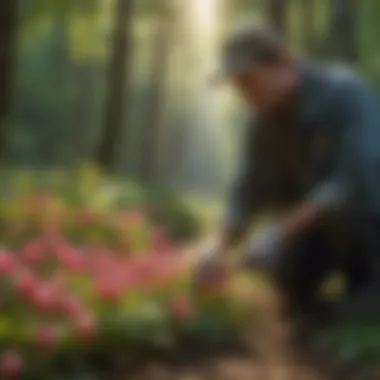

"To create a thriving ecosystem, we need to think beyond aesthetic value and recognize the intricate relationships between plants and their pollinators."
Role in Soil Health
Beyond attracting pollinators, bleeding heart plants also contribute to soil health in several ways. Their root systems can improve soil quality through nutrient cycling and organic matter contributions.
- Nutrient Contributions: As these plants grow and later die back in the fall, they leave behind organic material that enriches the soil. This decomposition process not only adds nutrients but also improves soil structure.
- Erosion Prevention: The plant’s roots help bind the soil, reducing erosion. In areas prone to water runoff, having bleeding hearts can mitigate soil loss and maintain land integrity.
- Mycorrhizal Relationships: Bleeding hearts often form symbiotic relationships with mycorrhizal fungi. These fungi extend the plant’s root system and enhance nutrient uptake, particularly phosphorus, which is essential for plant health and growth.
Conservation Efforts
Conservation efforts surrounding bleeding heart plants are crucial for ensuring their survival and maintaining the biodiversity of natural habitats. These efforts not only protect the plants themselves but also enhance the ecosystems in which they thrive. By safeguarding bleeding hearts, we contribute to the broader initiative of preserving unique flora and fauna that enrich our environment.
Threats to Natural Populations
Bleeding heart plants face several threats that can impact their populations in the wild. Among the most significant are habitat destruction, invasive species, and climate change.
- Habitat Destruction: The conversion of forests and meadows into agricultural land or urban areas significantly reduces the available space for these plants to grow. Deforestation and land development often lead to fragmentation of their natural habitats, making it difficult for bleeding hearts to thrive.
- Invasive Species: Non-native plants can outcompete bleeding hearts for resources such as water, nutrients, and sunlight. These invasive species disrupt the balance of local ecosystems, threatening the survival of native plants.
- Climate Change: Fluctuating temperatures and altered rainfall patterns can affect the moisture levels that bleeding hearts require. Changing weather conditions might push them out of favorable habitats, creating additional stress on their populations.
Understanding these threats is essential, as it provides the context needed for effective conservation strategies.
Community Initiatives
Various community initiatives have arisen to combat the decline of bleeding heart plants and support their conservation. These grassroots efforts are often driven by passionate individuals and organizations dedicated to environmental stewardship. Some prominent initiatives include:
- Local Planting Programs: Many communities organize public planting days to restore native flora to local parks and wildlife areas. Engaging volunteers in these activities not only raises awareness but also fosters a sense of community ownership towards environmental efforts.
- Educational Workshops: Educating the public about the importance of bleeding heart plants contributes to a greater understanding of their ecological roles. Workshops can cover proper gardening techniques and the significance of supporting biodiversity in urban areas.
- Citizen Science Projects: Involving local residents in monitoring bleeding heart populations can provide invaluable data for researchers. Projects that encourage people to report sightings or track changes over time have proven effective in conservation science.
By bringing together volunteers and enthusiasts, these initiatives can build a solid foundation for the long-term conservation of bleeding hearts, ensuring they continue to grace our landscapes for generations to come.
Through a combination of awareness, community effort, and scientific study, we can work towards ensuring that these delicate plants not only survive but flourish in their natural settings.
Additional Resources for Enthusiasts
Understanding where to find bleeding heart plants goes beyond mere location. It taps into a web of shared knowledge and passion among gardeners, botanists, and nature lovers. In particular, additional resources for enthusiasts serve as a cornerstone for those seeking to deepen their expertise, enhance their garden's biodiversity, and foster responsible gardening practices. These resources not only offer practical advice but also enable enthusiasts to connect with like-minded individuals.
Exploring this landscape of information can significantly impact both appreciation and cultivation of bleeding heart plants. Listed below are key elements to consider:
- Diverse Learning Platforms: Finding the right channels for information is crucial. Online communities, forums, and educational literature provide a wealth of insights and experiences that can help in successful cultivation and care.
- Networking Opportunities: Engaging with online communities enables real-time sharing of tips and troubleshooting challenges that arise while growing these plants. Networking not only promotes personal learning but also encourages collaborative initiatives aimed at conservation of bleeding heart plants.
- Increasing Awareness: Understanding the ecological importance of bleeding heart plants creates a stronger bond between enthusiasts and their conservation efforts. Recognizing their role in local ecosystems allows individuals to be more intentional in their gardening choices.
By taking advantage of these resources, enthusiasts can cultivate a nuanced understanding of their beloved plants, transforming their gardening experience into something richer and more connected.
"Nature is an endless source of inspiration and learning; sharing that journey enhances our understanding of the world around us."
Online Communities
Digital platforms have become vibrant ecosystems of knowledge and support for gardeners. These online communities—ranging from dedicated forums to social media groups—offer a unique space for enthusiasts to share experiences, ask questions, and celebrate their love for bleeding heart plants. Some noteworthy places to connect include:
- Facebook Groups: Numerous groups focus on specific plant varieties or gardening techniques. Engaging in such groups allows for immediate feedback and a broad exchange of ideas.
- Reddit Forums: Subreddits dedicated to gardening can serve as a treasure trove of information, with users often sharing their firsthand experiences about growing bleeding heart plants.
- Local Gardening Clubs: Many communities have online presences where they post updates about meetings, plant swaps, and educational events.
Participating in these groups cultivates a sense of belonging and shared purpose, broadening one’s understanding through collective wisdom.
Educational Literature
Books, research papers, and articles can significantly elevate a gardener's grasp of bleeding heart plants. Literature offers in-depth information that might not surface in casual conversations. Here are key types of educational resources:
- Botanical Guides: These often provide detailed species descriptions, ideal growing conditions, and insights into pest management. Familiarizing oneself with proper guides is fundamental for grounding new knowledge.
- Gardening Magazines: Many publications profile the latest in gardening trends, including features on bleeding heart plants. They often highlight innovative gardening techniques and eco-friendly practices that can enhance any garden.
- Academic Journals: For those interested in a scholarly approach, journals present research about bleeding heart plants' ecological impact, their genetics, and conservation efforts.
Acquiring and engaging with educational material not only bolsters one’s gardening skills but also fosters a deeper appreciation for the nuances that make bleeding heart plants unique. The journey of exploration through these resources contributes to overall knowledge and sensitivity towards the environment.


